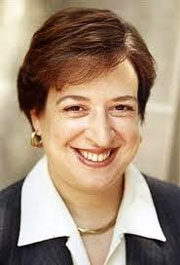Supremely Slanted
Table of Contents:
Elena Kagan
 The Times also denied the clear liberal background and world-view of Obama's next Supreme Court appointee. Elena Kagan served in the Clinton White House and was Dean of Harvard Law School before joining the Obama administration as solicitor general. A former clerk for liberal Justice Thurgood Marshall, she was the first non-judge to be appointed to the high court since 1972.
The Times also denied the clear liberal background and world-view of Obama's next Supreme Court appointee. Elena Kagan served in the Clinton White House and was Dean of Harvard Law School before joining the Obama administration as solicitor general. A former clerk for liberal Justice Thurgood Marshall, she was the first non-judge to be appointed to the high court since 1972.
Kagan worked for two Democratic administrations (Clinton and Obama) in similar fashion to John Roberts (Reagan and the first President Bush), and banned the military from recruiting at Harvard Law School in reaction to the ban on openly gay soldiers -- ironically, a policy brought about by the same Clinton administration Kagan helped sell policy for.
Yet the Times didn't find her liberal Democratic background as interesting or controversial as it did Roberts' conservatism.
Kagan first showed up on the media radar a year before, during the speculation over Obama's first pick, which turned out to be Sonia Sotomayor. The first concerns raised by the Times were that Kagan, might be too bipartisan. In a story outside the Kagan study period, reporter Eric Lichtblau speculated on May 17, 2009, before Obama picked Sotomayor: “Potential Justice's Appeal May Be Too Bipartisan.” The text box emphasized: "Some admirers on the left worry about all those admirers on the right." It's safe to say the Times never concerned itself that Republican nominees might have too much appeal for Democrats; over the years the Times has practically demanded that Republicans pick non-conservative nominees with bipartisan appeal.
The Times labeled Kagan a liberal on a mere four occasions, and even those were hedged. Sheryl Gay Stolberg admitted a “recurrent theme” in Kagan's work as a law clerk for Justice Marshall was “a generally liberal approach to law-enforcement issues,” and there were two mentions of Kagan being a product of the “liberal Upper West Side.”
Three days before her nomination, reporter Katharine Seelye set the tone on Kagan's alleged moderate views, calling the military-banning Kagan a “pragmatist.” On the morning of her nomination, May 10, Peter Baker and Jeff Zeleny made the same argument: “Liberals dislike her support for strong executive power and outreach to conservatives while running the law school.”
After Obama officially put forward her name, the Times ran “Pragmatic New Yorker Chose a Careful Path to Washington” May 11. Interestingly, the lead sentence pronounced Kagan “a product of Manhattan's liberal, intellectual Upper West Side,” but that was the closest thing to an ideological label the Times gave Kagan in the entire 4,200-word profile introducing her to Americans.
Peter Baker's accompanying story, “Liberal, in Moderation” hedged on its labeling, admitting Kagan was liberal only in comparison to conservatives (“too liberal for conservatives”) while insisting Kagan “does not fit the profile sought by the left” to balance aggressive conservative Justice Scalia. Sure enough, a May 14 story by Seelye suggested Kagan was not left-wing enough on race matters, since she was accused by some of “not creating enough racial diversity at Harvard.”
Though Republican opposition to Kagan became stronger as time passed, the Times found little exciting on Kagan's heavily vetted path to confirmation, ignoring concerns about her college-age revulsion of Ronald Reagan, and seeing nothing particularly ideological about her activism against military recruitment.
Sheryl Gay Stolberg gushed over Kagan on a June 28 podcast at nytimes.com, on the eve of the hearings, in the same manner reporter Jodi Kantor had for Sotomayor a year before: “Let's not forget that Elena Kagan has been an academic. She is a brilliant woman. She's somebody who is also very funny and warm and witty, and I think Americans will see that when they -- when she comes before the Senate today.”
Conclusion
As dramatically as the “confirmation process” has been shifted by liberal activists since the days that William Douglas passed muster without a single question, a crucial part of the “confirmation process” is the journalism that is committed (or omitted) by national newspapers like the Times. Newspaper reporters and editors aren’t writing the first draft of history. They’re trying to make history happen with a happy ending for liberals.


